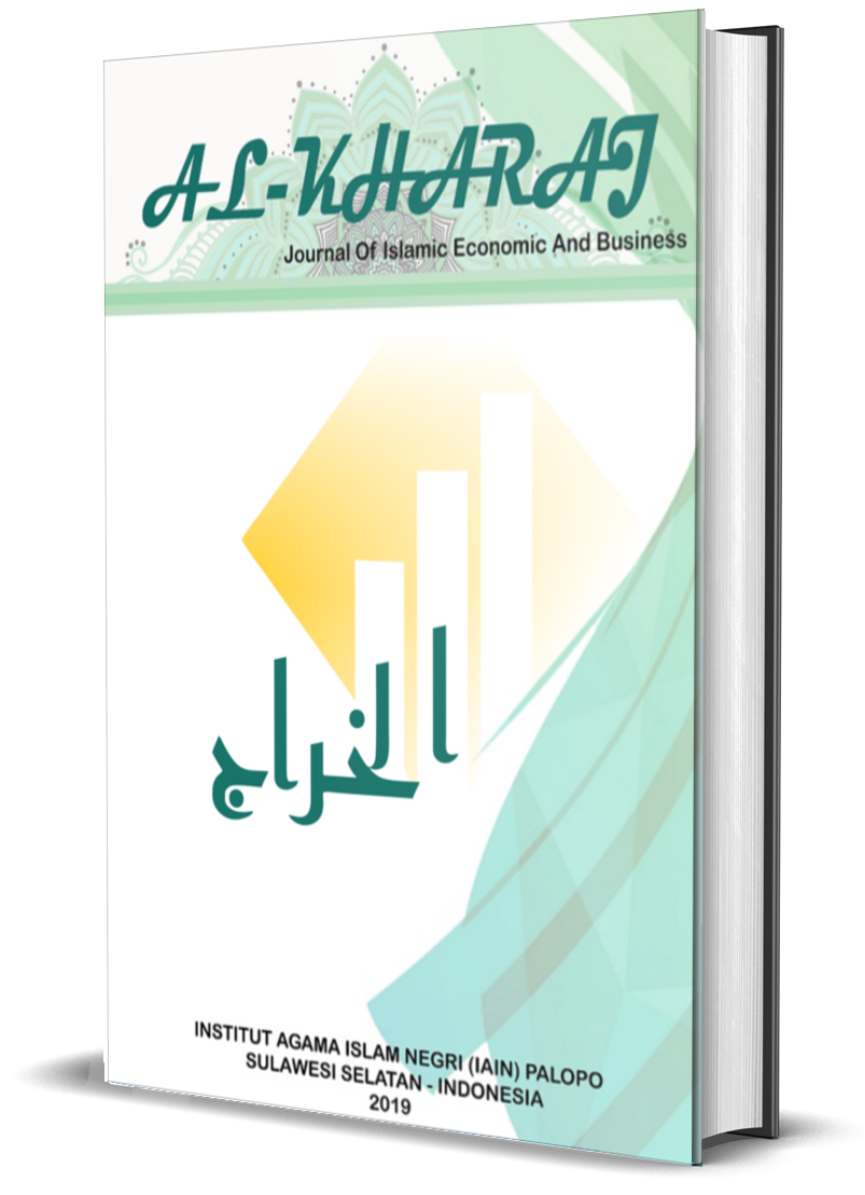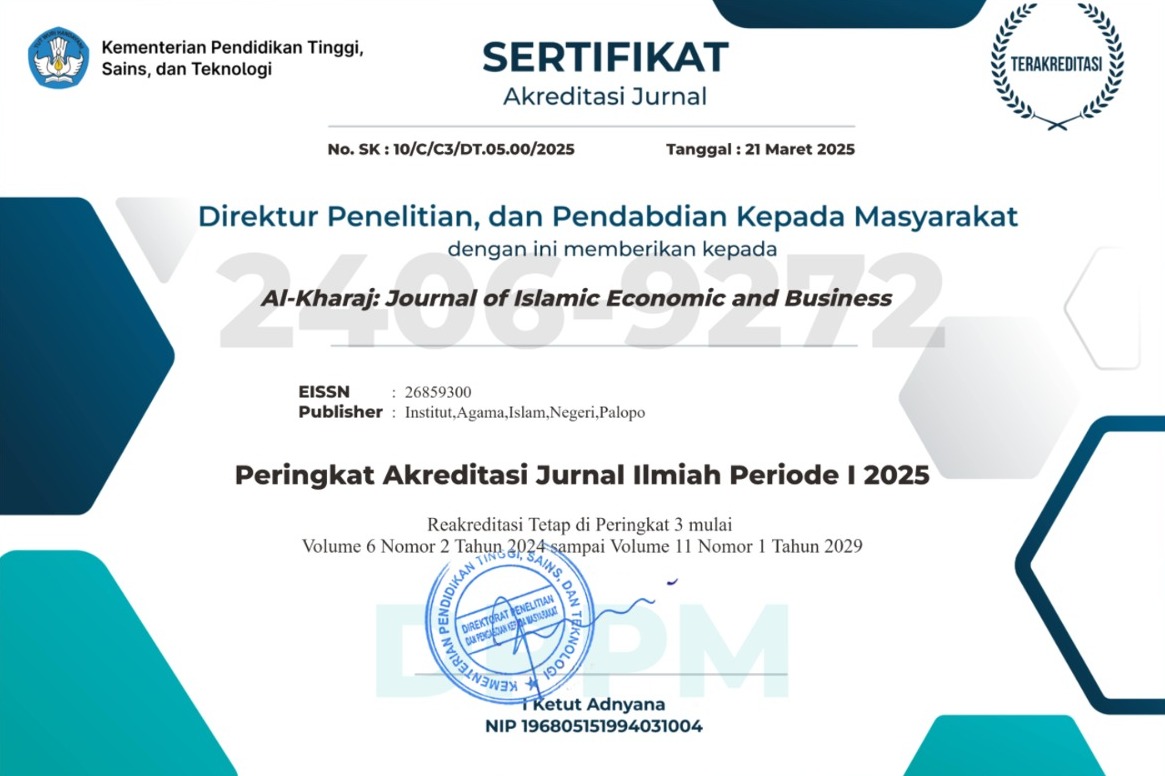Understanding Tax Avoidance on Bank Debts Reviewed from the Letter An Nisa 29
DOI:
https://doi.org/10.24256/kharaj.v7i2.6802Keywords:
Tax Avoidance; Bank Debt; Surah An-Nisa verse 29Abstract
Purpose: This study aims to analyze tax avoidance on bank debts reviewed from the letter An Nisa 29 by paying attention to Islamic business ethics and the perspective of the letter An-Nisa verse 29.
Method: This study uses a qualitative approach with the type of library research. The data collection techniques used in this study are non-participant observation, interviews, and libraries. Data are analyzed using data reduction, data presentation, and drawing conclusions.
Results: The main principles in Islamic business ethics that are contrary to tax avoidance include the principle of honesty, the principle of awareness of social significance in business activities, the principle of justice, the principle of good intentions, and the principle of trust. Thus it is clear that tax avoidance which is part of a vicious circle is prohibited in Islam. Based on Surah An-Nisa verse 29 there are four main points of discussion that can be developed to see tax avoidance activities on bank debt. The four points are wealth, false path, mutual consent, and do not kill yourselves.
Implications: This research provides implications for accounting science, especially regarding the analysis of tax avoidance on bank debt as reviewed from the letter An Nisa 29.
Novelty: This study focuses on the analysis of tax avoidance on bank debt reviewed from the letter An Nisa 29 with indicators of Islamic business ethics, namely the principle of honesty, the principle of awareness of social significance in business activities, the principle of justice, the principle of good intentions, and the principle of trust. Then integrated into the review of the letter An-Nisa verse 29 there are four main points of discussion, namely wealth, the wrong path, mutual consent, and do not kill yourselves.
References
Ahyar, H., Ustiawaty, J., & Andriani, H. (2020). Buku Metode Penelitian Kualitatif & Kuantitatif. CV. Grup Pustaka Ilmu.
Al Hifnawi, M. I. (2007). Tafsir Al-Qurthubi (5th ed.). Pustaka Azzam.
Antonio, M. S. (2023). How Far has Islamic Business Ethic been Researched? Business and Sustainability, 2(1). https://doi.org/10.58968/bs.v2i1.328
Chapra, M. U. (2000). Islam dan Tantangan Ekonomi. Gema Insani.
Departemen Agama Republik Indonesia. (2009a). TAFSIR TEMATIK: Pembangunan Ekonomi Umat. Lajnah Pentashihan Mushaf Al-Qur’an.
Departemen Agama Republik Indonesia. (2009b). TAFSIR TEMATIK: Pembangunan Ekonomi Umat. Lajnah Pentashihan Mushaf Al-Qur’an.
Fawzi Shubita, M. (2024). The relationship between sales growth, profitability, and tax avoidance. Innovative Marketing, 20(1), 113–121. https://doi.org/10.21511/im.20(1).2024.10
Hidayat, W. W. (2018). Pengaruh Profitabilitas, Leverage Dan Pertumbuhan Penjualan Terhadap Penghindaran Pajak. Jurnal Riset Manajemen Dan Bisnis (JRMB) Fakultas Ekonomi UNIAT, 3(1), 19–26. https://doi.org/10.36226/jrmb.v3i1.82
Huda, M. (2007). Aspek Ekonomi dalam Syari’at Islam. LKBH IAIN Mataram.
Idri. (2010). Hadis Ekonomi: Ekonomi dalam Perspektif Hadis Nabi. Kencana.
Inanda, T. U., Suranta, E., & Midiastuty, P. P. (2018). Pengaruh Penghindaran Pajak Terhadap Nilai Perusahaan Yang Dimoderasi Oleh Corporate Governance Dan Kepemilikan Mayoritas. Jurnal Akuntansi, 12(2), 126–145. https://doi.org/10.25170/jara.v12i2.85
Inten, SE. , M. Si. , D. A. R. (2020). Pengaruh Perputaran Persediaan Dan Perputaran Hutang Terhadap Solvabilitas. Jurnal Akuntansi Dan Bisnis Krisnadwipayana, 7(2). https://doi.org/10.35137/jabk.v7i2.379
Katz, S. P., Khan, U., & Schmidt, A. P. (2013). Tax Avoidance and Future Profitability. SSRN Electronic Journal. https://doi.org/10.2139/ssrn.2227149
Mahendra, P. T. (2015). Pengaruh Kebijakan Hutang, Struktur Modal Dan Profitabilitas Terhadap Aktivitas Investasi Perusahaan Manufaktur Barang Konsumsi Yang Terdaftar Di Bursa Efek Indonesia. Eksis: Jurnal Riset Ekonomi Dan Bisnis, 10(2). https://doi.org/10.26533/eksis.v10i2.62
Masrur, M. (2018). Kontruksi Harta dalam Perspektif Hukum Ekonomi Syariah (Studi Analisis dalam al-Qurâ€TMan dan Hadis). JURNAL HUKUM ISLAM, 95–128. https://doi.org/10.28918/jhi.v15i1.801
Midiastuti, P., & Suranta, E. (2016). Penghindaran Pajak, Corporate Governance dan Biaya Utang. Universitas Bengkulu.
Moleong, L. J. (2016). Metodologi Penelitian Kualitatif. PT. Remaja Rosdakarya.
Munandar, A., & Ridwan, A. H. (2023). Tafsir Surah An-Nisa Ayat 29 Sebagai Landasan Hukum Akad Ba’i Assalam Dalam Praktek Jual Beli Online. Rayah Al-Islam, 7(1), 271–287.
Nursopyan, L. E., & Gunardi. (2022). Pengaruh Utang Bank Dan Pendapatan Tehadap Laba Bersih Pada PT. Sinkona Indonesia Lestari. Management Studies and Entrepreneurship Journal (MSEJ), 3(1).
Putri, V. R., Mohamad Yunus, M. H. S., Zakaria, N. B., Zifi, M. P., Sastrodiharjo, I., & Dewi, R. (2024). Tax Avoidance with Maqasid Syariah: Empirical Insights on Derivatives, Debt Shifting, Transfer Pricing, and Financial Distress. Journal of Risk and Financial Management, 17(11), 519. https://doi.org/10.3390/jrfm17110519
Qordowi, Y. (1997). Norma dan Etika Ekonomi Islam. Gema Insani.
Safitri, D. A., & Barli, H. (2024). Pengaruh Kebijakan Utang, Capital Intensity dan Ukuran Perusahaan terhadap Agresivitas Pajak. Jurnal Ilmiah Akuntansi Universitas Pamulang, 11(1), 73–84. https://doi.org/10.32493/jiaup.v11i1.37659
Shihab, M. Q. (2005). TAFSIR AL-MISBAH: Pesan, Kesan Dan Keserasian Al-Qur’an, (4th ed.). Lentara Hati.
Sulaeman, R. (2021). Pengaruh Profitabilitas, Leverage dan Ukuran Perusahaan Terhadap Penghindaran Pajak (Tax Avoidance). Syntax Idea, 3(2), 354. https://doi.org/10.36418/syntax-idea.v3i2.1050
Taufiq, T. (2018). Memakan Harta Secara Batil (Perspektif Surat An-Nisa: 29 dan At-Taubah: 34). JURIS (Jurnal Ilmiah Syariah), 17(2), 245. https://doi.org/10.31958/juris.v17i2.1162
Wijaya, A. T., & Fikri, M. A. (2020). Analisis Pengaruh Kebijakan Hutang Terhadap Kinerja Keuangan. Jurnal Fokus Manajemen Bisnis, 9(1), 35. https://doi.org/10.12928/fokus.v9i1.1548
Downloads
Published
How to Cite
Issue
Section
Citation Check
License
Copyright (c) 2025 Alan Januar Ahmed, Driana Leniwati, Ahmad Juanda

This work is licensed under a Creative Commons Attribution-ShareAlike 4.0 International License.
Authors retain copyright and grant the journal right of first publication with the work simultaneously licensed under a Creative Commons Attribution-ShareAlike 4.0 International License. In line with the license, authors are allowed to share and adapt the material. In addition, the material must be given appropriate credit, provided with a link to the license, and indicated if changes were made. If authors remix, transform or build upon the material, authors must distribute their contributions under the same license as the original.









